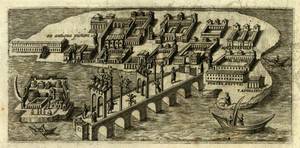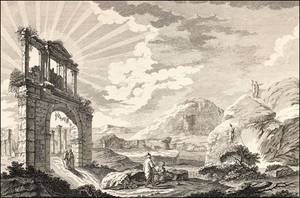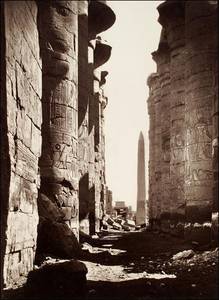Project Description
- Contents
- Digitizing
- Bibliographical Indexing
- Indexing of Objects (Stoch's Gemm Collection)
- Publications on the project
The aim of the project is the reconstruction and online publication of about 1700 prints, which appeared between 1500 and 1900. In a next step forms of semantic networks are to be approached in separate subprojects. This is to be illustrated through the direct contextualisation of objects from Philipp von Stosch's Gem Collection.
Contents
Digitizing an important part of the Old Prints, which between 1500 and 1900 appeared as a result of the debates on the excavations and findings of antique cultures in the Mediterranean, which had to the topic the Classical, Near Eastern and Egyptian Archeology, the project will be a structural improvement for History and Art Studies.
This source material is seen basically for a file of scientific studies, of them the analyses of the gem collections and the history of the reception of antique sculpture both already are integrated into the project.
As far as concerned the title selection at the German Archeological Institute the main area of the collection concerns Rome an the other parts of Italy. Therefore by the title selection the focus lies on these regions as well. At the Heidelberg University Library the focus for the digitizing lies on titles relating Ancient Greece, Turkey and the remaining part of the Eastern Mediterranian Region.
Both cooperation partners have excellent and complementary collections, which not only reflect an essential part of the reception of Antiquity of this epoch but furthermore document the history of Archaeology and Egyptology as such.
German Archaeological Institute (DAI)
The prints from the German Archaeological Institute , which will be digitized, appeared between 1500 and 1830. The prints document the development of the analysis with the material heritage of the antique world from the Renaissance until the Enlightenment and the establishment of the classical archaeology as a self-acting discipline. The entire collection from this time in the German Archaeological Institute represents about 1800 prints, of which around 900 volumes will be digitized.
A focus of the rare prints collection naturally lies in the topography of Rome and Italy, not only because of the location of the library, but also because Rome has become a centre for antique studies since the return of the Popes from exile in Avignon. These studies had the aim to bring the antique finds and the topography of the antique Rome into accordance with the information from the antique authors. The works of most antiquarians still exist in the library of the German Archaeological Institute. Amongst them are the studies of G.P. Leto and F. Blondus, who oriented themselves solely at the antique scripts, the works of the first special researcher A. Fulvio as well as of the late compiler as R. Venuti. Often there were several editions and translations. Already in the 16th century many special studies about the different kinds of monuments were written with a topographical approach. These progresses continued, and in the following era new fields of research were founded, which had an effect upon the art and culture of this period. Some early examples are U. Aldrovandi on sculpture, P. Apianus and J. Mazochius on inscriptions and F. Orsini on numismatics.
The increase of antique collections all over Europe resulted in the flourish of antiquarian scholarship. It’s main concern was to put real objects into relation with persons or events, which are known in written records. Further centres of interests were in Rome and other Italian cities, where the scholars travelled to increasingly. Beside the topographical studies and corpora to the different kinds of monuments, enormous catalogues about the collections were written, which are in the holding of the library of the German Archaeological Institute. Some examples are the works of H. Prideaux, F. Gori and E. Pistolesi.
Towards the 18th century, the library had a rich inventory. At the beginning of Enlightenment the discussion about the antique monuments became more objective and through systematization and comparison the studies on artefacts and written records finally became organized.
Numerous works like the Geschichte der Kunst des Alterthums from J.J. Winckelmann from 1764, which reflect the summit of these developments, are held in the library of the German Institute of Archaeology. Also the publications on the excavations, which were then realized with more scientific methods, are part of the library collection. The Italian polymath F. Bianchini and in particular his book Del Palazzo de’Cesari, 1738, for example was an early pioneer of field research. However, especially the excavations of the House of Bourbon at Herculaneum and Pompeii broadened the perspective on the Antiquity. They were published in a multipart edition Le antichità die Ercolano esposte, 1757-1792. Numerous smaller items from independent scholars complete these collections.
At about the same time the ancient ruins of Greek towns in southern Italy and Sicily aroused the interest of the scholars and large engravings and scientific papers like those by G. Pancrazi and J.P. D’Orville emerged. At the end of these developments a scientific discipline had come into being, to which as a part of the ancient studies was given a lively interest. Goethe’s enthusiasm for Antiquity is proof for it as well as the establishment of professorships at the universities, and finally also the foundation of the Instituto di Corrispondenza Archeologica 1829 at Rome with the protectorate of the Crown Prince Friedrich Wilhelm of Prussia.
The presentation and indexing of these old prints form the early days of Archaeology is not only a contribution to the subject itself but also beyond it, to the interdisciplinary scholarship of cultural history.
Heidelberg University Library
From the collections of the University Library of Heidelberg about 800 volumes on the topography and art of ancient Greece, Turkey, Syria, Jordan and Egypt will be selected for digitization. These volumes impart the knowledge on Antiquity in the time of the 17th until the 19th century. Sometimes information on monuments of the Byzantine era is included. The complex concerns illustrated books as well as excavation bulletins, travel reports and theoretic works about the antique locations and collections, which have appeared since the 18th century and document the formation of Archaeology and the Egyptology to independent disciplines in this period. Among the about 500 titles from the section of Archaeology, which shall be digitized, one of the earliest works from 1678 is the travel report from J. Spon and G. Wheler, the first topography of Athens and Greece with attempts for scientific criteria; for more than a half century the contained illustrations remained the most important source of information for the architecture of Antiquity. As an example for the first big wave of luxurious volumes, which started in about 1750 and in, which France and Great Britain began a contest in the field of archaeology, the main works of R. Wood about the ruins of Palmyra and Baalbeck are to be mentioned. In these as well as in the works of J. Stuart and N. Revett or the French architect J.-D. Le Roy and some others the new type of documentation of Antiquity is represented. These works are the results of organized archaeological expeditions, where the findings of facts on Greek monuments were executed methodically. Another important category in the sector of Archaeology is the travel reports with large-sized engravings of regions, which were little known at that time. In the 18th century these kinds of works received a real inflationary impulse, such as for example the opus of H. Maundrell, J.P. Tournefort, L.F. Cassas or W.R. Hamilton. These works are valuable for current research because they often combine the original information on the travel with descriptions of monuments, which today are so important, and scientific research. Furthermore, a set of basic catalogues of the collections are selected.
The selected Egyptology literature (about 300 volumes) documents Egypt and its antique monuments, at a time when there were no or only little destructions. At the beginning of the 20th century the tombs, temples and pyramids could be observed by travellers to a large extent in their original condition. As a result of their descriptions and drawings the original situation could be obtained. Amongst them were the engravings by F. Norden with high quality veduta, documentation of buildings and detailed maps. It was the first publication to only regard Egypt.
Also R. Pococke’s Description of the East from 1743 is notable for the beginning of the field of study of the Egyptology. Furthermore, the volumes of J.F. L. Grobert and W. Osburn have to be mentioned in this context. After the time, when J.-F. Champollion decoded the hieroglyphs in 1822, the first scientific excavations began. For this W.M.F. Petrie, A.E. Mariette or H. Brugsch are mentioned exemplary. Their publications are still a focus of current research.
The central works concerning antique topography and art of the Mediterranean area are available in the Heidelberg University Library not only as original editions but also often as (German) translations. The latter are of importance to research on the reception of antiquity, because thanks to them the reader in German speaking areas gained knowledge on this subject.
Winckelmann-Gesellschaft Stendal
The digitizing and inventory of the dactyliothec of the Baron Philipp von Stosch will be done by the Winckelmann-Gesellschaft.
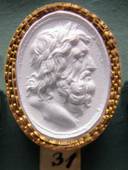
The collection of originals and reproductions of antic, modern and after antic originals modelled intaglios contains about 3500 exemplars. These intaglios inform us about a lot of topics as mythology, warfare, child education, fashion, famous persons or science in the ancient world. Further the Winckelmann-Gesellschaft will study the reception of the antic intaglios from the 1600 to the 1900 by sorting through the prints of these period for illustrations of the Stosch’s gem collection. As the result of the project the first time there will be free accessibly in the web an all-embracing collection of antic artefacts including the scientific reception for all interested persons.
Digitizing
The digitizing of the prints from the German Archaeological Institute in Rome will be done by an external service provider. The bibliographic details of the prints will be implemented in ZENON DAI by the German Archaeological Institute in Rome, the editing of the digitized data will be done by the Research Archive for Ancient Sculpture in Cologne, where they will be implemented into the iDAI.Bookbrowser (as a module of Arachne). The bibliographic metadata will be added in Cologne as well. This happens directly within Arachne.
The digitized book in the iDAI.Bookbrowser will be linked with the corresponding dataset in ZENON DAI, which will be shown on the website. Furthermore, the URL of the digitized book in the iDAI.Bookbrowser will be included in the ZENON dataset.
As the project progresses it is intended to scan the digitized books with OCR in order to provide a full text search option. The long-term archiving will be done at the computer-centre of the University of Cologne and in Berlin at the central office of the German Archaeological Institute in cooperation with the Konrad Zuse computer-centre.
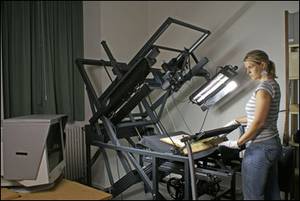
All the books, which are to be edited within the framework of the project, will be digitized in the Digitization Department of Heidelberg University Library. Also the preparation for the internet presentation will be done there. The long-term archiving will take place in Heidelberg. For most of the books, which are printed with modern typefaces, a full text search option will be provided by means of OCR. Further information on the workflow and the employed technology you can find here.
Bibliographic Indexing
The bibliographic metadata of the digitized texts at Rome will be indexed in ZENON (Aleph) according to the Anglo-American Cataloguing Regulations, Old Prints. Thus, the demands for the delivery of the data to EROMM and ZVDD are met. At ZENON the works will receive a permanent link to the digitized book at Arachne. The indexed bibliographic details will be addressed directly from Arachne.
At Heidelberg University Library the digital reproductions will be indexed in the South-West-Library Network (SWB) according to formal (RAK) and factual regulations (RSWK and DDC). The data will be delivered to EROMM and ZVDD. All titles digitized in the context of the project can be searched through the metadata-search option PropylaeumSEARCH of the Virtual Library Archaeology and by an OAI-gateway, which is linked with further national and international research tools.
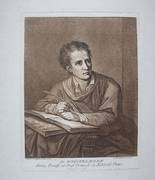
Indexing of Objects (Stosch’s Gem Collection)
The gem collection of Stosch will be linked with Arachne the data base for archaeological images and objects in an exemplary manner. The description of J.J. Winckelmann of this famous gem collection is without illustrations. Nevertheless, from a data base perspective he lists a wide range of single objects, even if they are only described textually. Unlike in the the projects Clarac and Mafeiano not the illustrations of the objects are the main focus of the contextualization but the descriptions, which are to be encoded in a web generated form in Arachne according to TEI regulations.
Because of the catalogue form of the Winckelmann-Text the reference to the objects will be the central point of the contextualization. Based on the text the manual contextualization will be linked with the about 3.500 imprints of the Daktyliothek of the Stosch’s Gem Collection. These roll marks have already been digitized completely, so that the scans can be used for the project. Furthermore, since 1996 a part of imprints has been identified in the publications of the edition of Winckelmann-Writings, the rest will be researched during the project.
The data modelling through the linking of thematic units in the text with information units in Arachne follows the categories of Arachne in regard to the concept. The Arachne-Thesaurus will be used for terminology, which successively will be linked with the thesauri of other divisions of the DAI (ZENON DAI, Emagines/Image Finder).
In the context of the project the conceptual range of the Stosch’s Gem Collection will be prepared systematically as a part of the standard of documentation of the cultural studies. In Arachne the areas reproduction, reception, single object, scene, motive and collection are concerned. The according structures from ICONCLASS, HiDa/MIDA, »Museumdat« will be connected in a concordance to Arachne and potentially missing sections will be added. Simultaneously the semantic sector in Arachne, which is directly concerned by the project, and the previously mentioned standards of documentation will be converted into a hierarchic thesaurus- structure. This structure will be linked to the specific fields in Arachne and made researchable by the use of a thesaurus browser.
Publications on the project
- M. Effinger: Acht auf einen Streich: Propylaeum – Die Virtuelle Fachbibliothek Altertumswis-senschaften, in: Millennium. Jahrbuch zu Kultur und Geschichte des ersten Jahrtausends n. Chr. / Yearbook on the Culture and History of the First Millennium C.E. , 8, 2011, S. 1 - 18
- Rieger – H. Rose – J. Rychert – St. Steidle, Rezeption der Antike im Semantischen Netz, KuBA 1, 2011, 182–183.
- M. Remmy, Kontextualisierung der Gemmensammlung des Barons Philipp von Stosch, Ku-BA 1, 2011, 187-188.
- L. Berger – F. Kähler – M. Röhl – H. Rose – U. Stockinger, Rezeption der Antike im Seman-tischen Netz II, KuBA 2, 2012, 267–270.
- H. Rose – M. Röhl – L. Berger, Rezeption der Antike im Semantischen Netz III - Ergebnisse und Perspektiven, KuBA 3, 2013, 275–279.
- L. Berger – M. Röhl – H. Rose, Medium Stichwerke. Der Kupferstich in den archäologischen Wissenschaften, in: P. Scheding – M. Remmy (Hrsg.), Antike Plastik 5.0:// 50 Jahre Forschungsarchiv für Antike Plastik in Köln. Ausstellungskatalog Bonn (Berlin 2014), 182–190.



